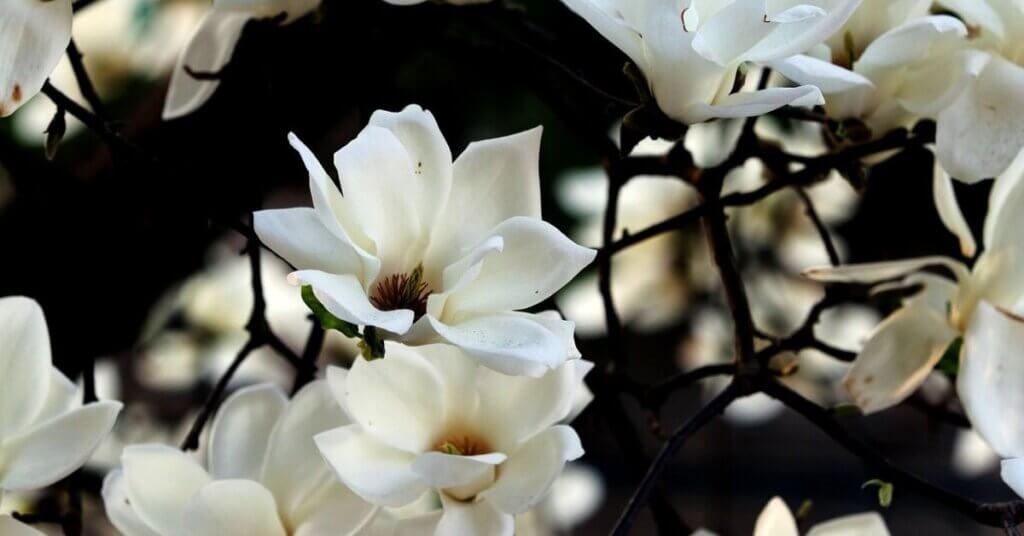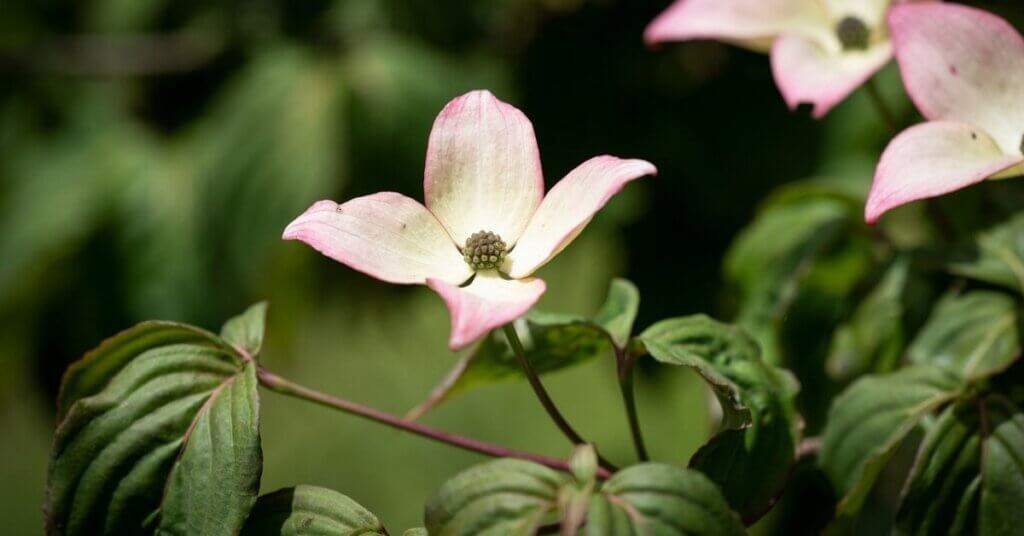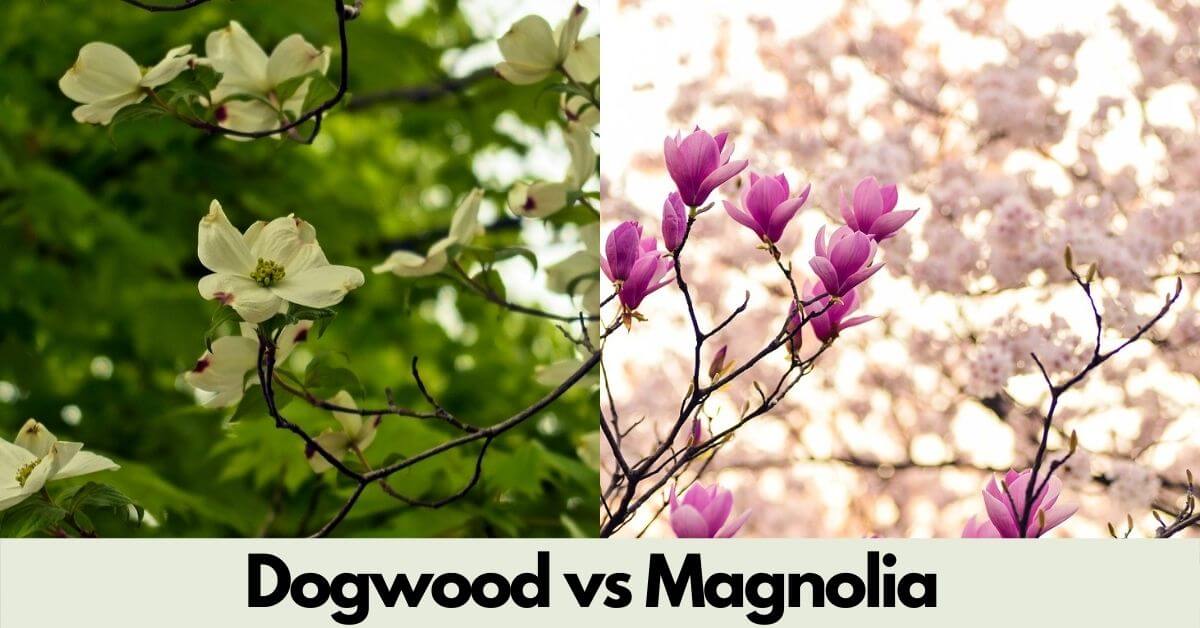Dogwood
Dogwood (Cornus florida) is a genus of about 30–60 species. It is native to eastern North America and northern Mexico. Some common Flowering species are Kousa dogwood, Pacific dogwood, and many more. Some of these are deciduous woody species or shrubs. Dogwoods have a lifespan of 70 to 80 years.
Magnolia
Magnolia is known as a flowering tree or shrub. It has about 210 species, some are huge trees and shrubs, native to North and South America, the Himalayas, and East Asia. Some common species are Anise Magnolia (Magnolia salicifolia), Bigleaf Magnolia (Magnolia macrophylla), Ashes Magnolia (Magnolia ashei), Cucumber Tree (Magnolia acuminata), etc.
| # | Dogwood | Magnolia (Southern Magnolia) |
| Scientific name: | Cornus florida | Magnolia grandiflora |
| Native to: | Eastern North America | North and South America, the Himalayas, and East Asia. |
| Tree Size | 30-40 ft (9-12 m) tall, 1-1.3 ft (.3-.4 m) trunk diameter | 50-80 ft (15-24 m) tall, 2-3 ft (.6-1 m) trunk diameter |
| Janka Hardness | 2,150 lbf (9,560 N) | 1,020 lbf (4,540 N) |
| Rot Resistant | No, susceptible to insect attack | No, susceptible to insect attack |
| Workability | Working can be a bit difficult. | Easy to work. |
| Color/Appearance: | pale pinkish to reddish-brown | creamy white to a grayish |
| Uses: | Ornamental tree, medical treatment, Golf club heads, textile shuttles, bows (archery), mallets, pulleys, and turned objects. | Veneer, plywood, interior trim, furniture frames, and medicine. |
Dogwood vs Magnolia Uses
Dogwood Tree and wood use
Wood uses: Dogwood is an extremely dense hardwood and stable. It is a great option for making sporting equipment such as Golf club heads, bows (archery). It is also converted into charcoal for gunpowder.
As an ornamental tree: Dogwood is a small flowering tree. It is planted as an ornamental tree. In native places, it is often seen on the side of the road, park, and residential. It is easily propagated by seeds.
In treatment: Native Americans use American dogwood to treat headaches, fatigue, fever, and diarrhea. But not to confuse American dogwood with Jamaican dogwood. Using Jamaican dogwood can be harmful to you. Jamaica dogwood is not recommended for human use.
Magnolia Uses
Furniture: Some large species of magnolia, such as the southern magnolia, are primarily used for making furniture.
Due to the straight grain and fine uniform texture. It is a great option for making Veneer, plywood, interior trim. Due to the straight grain and fine uniform texture. It is a better option for Veneer, plywood, interior trim.
In treatment: Many species of magnolia are used in medicine. Such as Houpo magnolia which is commonly known as “magnolia bark”. It is native to China. The bark, leaves, and flowers of the Houpo magnolia tree are used in traditional medicine to treat anxiety, depression, and other treatments.
Dogwood vs Magnolia Identification
Dogwood identification
It can generally be distinguished by its blossoms, berries, and distinctive bark. It is an ornamental tree that is preferred in the United States. Dogwood species are shrubs to deciduous trees and evergreens.
Dogwoods grow well in moist, well-drained, slightly acidic soil that contains organic matter.
Magnolia identification
Magnolia Sizes range from 15-ft shrubs to 80 ft massive trees. Large trees can have a span of up to 40ft. Magnolia trees and shrubs grow well in well-draining soil.
There are two types of magnolia tree: evergreen and deciduous. Evergreen species are suited to growing in warm climates and Deciduous species grow well in low-temperature climates.
Dogwood vs Magnolia leaves
| Dogwood leaves | Magnolia leaves |
| 1. Dogwood leaves have an oval shape, visible curved veins, smooth edges, and have a glossy look. 2. Leaves are 2” to 4” (5 – 10 cm) long. 3. Green above and slightly paler below 4. American Dogwood leaves turn a beautiful reddish color in autumn. 5. Leaves are alternately patterned. | 1. Magnolias have large, leathery leaves and are impressive. 2. Leaves are 4 and 8 inches (10 – 20 cm) long and about 5″ (12 cm) wide. 3. The Sweetbay tree, yellow magnolia, and pyramid magnolia have smaller leaves, about 4 to 6 inches in length. 4. The upper surface of a southern magnolia leaf is a dark green, and the underside is paler green |
Dogwood vs Magnolia Flowers


| Dogwood Flowers | Magnolia Flowers |
| 1. Generally, the flowers of dogwood shrubs/trees are white. But some other flowering species also produce pink, yellow, and yellow-green flowers. It depends on species to species. 2. Dogwood is a monoecious species that means separate male and female flowers on the same tree. 3. Flowers of dogwoods bloom in clusters from mid-March to May. | 1. There are many magnolia species, each with its own beautiful, distinctive blooms. 2. Magnolia trees produce purple, green, or even yellow flowers. But most common species produce white and pink flowers. 3. Magnolia flowers are either star-shaped or bowl-shaped. It depends on the species. Flowers can grow up to 12 to 15 inches across. |
Dogwood vs Magnolia Bark
| Dogwood Bark | Magnolia Bark |
| 1. Dogwood tree bark is dark brown or gray. 2. Young trees have smooth bark while turning very scaly to finely blocky with age. 3. The bark of the tree is relatively easy to peel. | 1. A young tree has a thin and smooth bark. 2. But as the tree ages, the bark becomes thick and has small cracks. 3. Southern magnolia bark is typically gray. |
Wood Color Difference Between Dogwood and Magnolia
| Dogwood wood color | Magnolia wood color |
| Dogwood’s heartwood is reddish-brown and sapwood is cream to pale pinkish in color. | Magnolia’s heartwood color ranges from a medium to dark brown, sometimes with green, purple, or black streaks. sapwood is a creamy white to a grayish color. |
Dogwood vs Magnolia Workability
Dogwood is hard and dense. Its Janka hardness is 2,150 lbf (9,560 N) and Crushing Strength is 8,740 lbf/in2 (60.3 MPa). Dogwood is difficult to work with. Because of its high density and interlocking grain pattern. Glues and finishes well.
Southern Magnolia is easier to work because it is a lower-density wood than dogwood. Its Janka Hardness is 1,020 lbf (4,540 N) and Crushing Strength is 5,460 lbf/in2 (37.7 MPa). Its Turns, glues, stains, and finishes well.
Dogwood vs Magnolia Rot Resistance
Dogwood and Magnolia are both rated as non-durable decay-resistant, and also susceptible to insect attack. Both kinds of wood do not survive in environmental conditions and are not reasonable for outdoor use.
Dogwood vs Magnolia Allergies/Toxicity
The Magnolia wood dust has been reported to cause asthma-like symptoms and a runny nose. While there is no health problem with Dogwood. But all kinds of wood dust are harmful to the asthma patient.
Therefore, before working with any kind of wood, protect your eyes and open body parts. Even if you are healthy.

